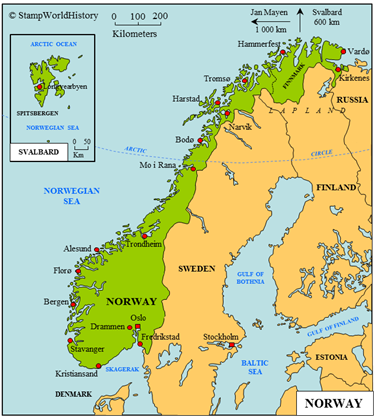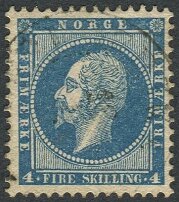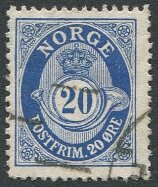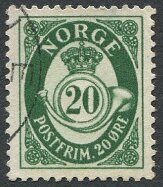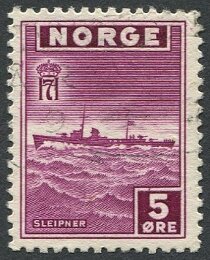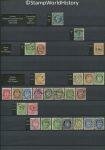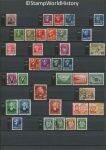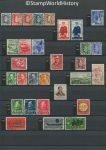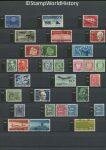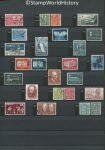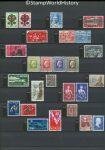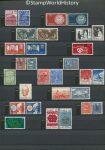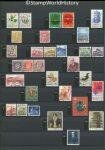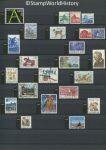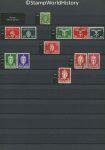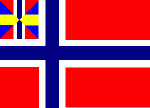
Norway
Union with Sweden
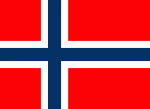
Norway
Kingdom
Quick reference
General issues: Kingdom in personal union with Sweden 1855-1905, Kingdom 1905-Present
Country name on general issues: Norge, Noreg
Special issues: Government in exile 1943-1945
Currency: 1 Speciedaler= 120 Skilling, 1 Skilling = 3.5 Øre 1855-1877, 1 Krone = 100 Øre 1877-Present
Population: 2 218 000 in 1900, 5 265 000 in 2016
Political history Norway
Norway until the early 19th century
Norway is located in northern Europe. The kingdom of Norway emerged in the 10th century – still in the Viking Age. Between the 8th and 11th centuries, the Vikings – Danes, Norwegians and Swedes – explored, raided and conquered territories all across Europe and across the Atlantic Ocean in North America. The Norwegians were most active on the British Isles and in the northern Atlantic. In the northern Atlantic, Viking settlements on the Faroe Islands, Greenland and Iceland evolved into lasting possessions of the kingdom of Norway.[1]The Faroe Islands formally became a Norwegian possession in 1035, Greenland in 1261 and Iceland in 1262. In 1397, through the Treaty of Kalmar, Norway and Sweden came to be ruled in personal union by the king of Denmark. Sweden separated from the union in 1523. The personal union between Denmark and Norway ended in 1814 through the Treaty of Kiel. Denmark had sided with Napoleonic France and, after Napoleon was defeated, was forced to cede Norway to Sweden. The Norwegian overseas possessions of the Faroe Islands, Greenland and Iceland had, since the personal union with Denmark, been developed by Denmark rather than Norway and were, therefore, awarded to Denmark.
Norway in the 19th century
The Norwegians, however, rose in opposition against the terms of the Treaty of Kiel. Norway declared independence, adopted a constitution, and appointed a king of their own choice. In a short war with Sweden, the Norwegian opposition was suppressed. Norway, though, retained its own constitution – amended to allow the Swedish king to rule Norway in personal union – and institutions, while Sweden took responsibility for Norwegian foreign policy. Towards the end of the 19th century, the call for full independence became stronger and, in 1905, the personal union with Sweden was peacefully dissolved. Norway became a kingdom in its own right. The Danish prince Carl of Denmark was elected king and upon his ascension to the throne adopted the name of Haakon VII.
Norwegian acquisitions in the Arctic and Antarctic regions in the 20th century
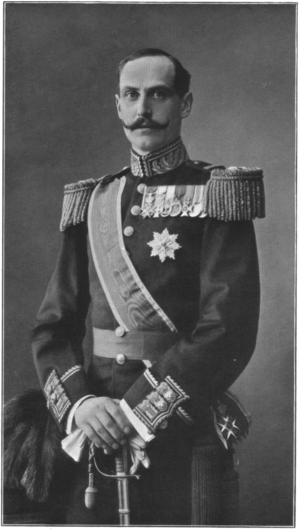
King Haakon VII was the first king of independent Norway. Haakon VII ascended to the throne in 1905 and, after 42 years of rule, was succeeded by his son Olav V in 1957.
Norway has a history of Arctic exploration[2]The most notable explorer is probably Roald Amundsen, who explored both the Arctic and Antarctic regions. and, in the first part of the 20th century, Norway gained possession of a number of territories in both the Arctic and Antarctic regions. In the Arctic region, Norway claimed the Svalbard Archipelago, located about 600 kilometers north of Norway.[3]Svalbard is traditionally known as Spitsbergen after the main island in the archipelago. Norwegian sovereignty was recognized, in 1920, and Svalbard was established as part of the kingdom in 1925. Furthermore, Norway claimed the island of Jan Mayen, located about a 1000 kilometers west of the North Cape. Jan Mayen became a de jure Norwegian possession in 1930. Svalbard has a permanent population, which mainly consists of Norwegian and Russian miners, while Jan Mayen only has temporary residents. In the Antarctic region, Norway gained Bouvet Island in 1930. Furthermore, Norway claims Peter I Island and Queen Maud Land. Both are subject to the Antarctic Treaty – signed in 1959, effective in 1961 – that pertains to the ice shelves, islands and mainland south of the 60th degree of south latitude. The treaty sets aside the Antarctic as a scientific preserve and stipulates that a presence in the Antarctic does not constitute a basis for a claim to de jure sovereignty. The Antarctic territories only have temporary residents and are governed as a dependency of the kingdom of Norway.[4]For the location of the Antarctic territories, please refer to the map of Antarctica. A 1931 claim to gain possession of part of Greenland – a Danish possession – was rejected by the Permanent Court of International Justice in 1933.
World War II
During WWI, Norway remained neutral. Although pursuing a policy of neutrality in the advent of WWII, Norway was occupied by Germany in 1940. The king and the government went into exile in Great Britain. Norway came to be administered by a German Reichskommissar[5]Reichskommissar literally translates to ‘Commissioner of the Empire’. In Nazi Germany it was the title of the German governors appointed to administer occupied countries. . In 1942, a collaborationist government was established, led by Vidrun Quisling, the leader of the small Norwegian national socialist party. From the small number of Norwegians that supported the German cause, some joined Norwegian units within the German SS elite forces – the ‘Norwegian Legion’. Resistance units were active throughout the war – the most notable feat may be the destruction of a heavy water plant that was part of the German nuclear program. Norwegians in exile formed the Free Norwegian Forces fighting along side the Allies. Possibly the most important contribution to the Allied cause was made by the Norwegian merchant fleet – the fourth largest in the world just prior to the war. The first step in the liberation of Norway was a Russian offensive that extended into Norway, liberating Kirkenes in 1944. Norwegian forces, subsequently, liberated the county[6]Counties are the Norwegian administrative level just below the national level. of Finnmark in the course of 1944 and 1945. Without the need for further military action, all of Norway was liberated when Germany capitulated in May 1945.
Politics in modern Norway
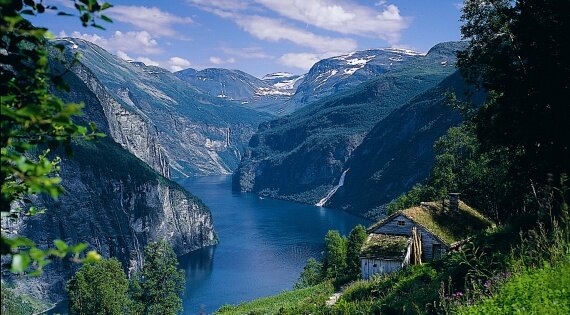
Norway is known for its fjords – inlets cut out by glaciers reaching deep inland.
Politically, Norway has been, since 1905, a stable constitutional monarchy and a parliamentary democracy. In the 20th century, Norwegian politics have long been dominated by the social democratic side of the political spectrum. Norway developed into a welfare state, after the Scandinavian model, with a high government involvement in the economy and in sectors such as education, health care and social security. Norway is not a member of the European Union. It is, though, a part of the European Economic Area that allows for free exchange of people, goods, services and capital between its participants.
Economics and demography
Economically, Norway was, traditionally, a country depending on agriculture, timber and fishing. Industrialization developed in the mid 19th century. Oil and gas finds, since the 1960’s, have become an important contributor to the GDP. Currently, Norway is the fourth oil exporting country in the world. Rather than take advantage of the of oil and gas production revenues directly, a significant part is invested in a state fund to to extend the benefits into the future. Modern Norway has a mixed economy and ranks among the wealthiest countries in the world. In terms of per capita GDP in ranks 11th in the world. On the United Nations Human Development Index, Norway ranks first in the world. The population is 94% Norwegian, the remainder being immigrants of European and other origins. A small population of Sami lives in northern Norway. The Sami are an indigenous semi nomadic people also found in the north of Sweden, Finland and Russia.[7]The Sami are also known, traditionally, as Lapps or Laplanders, after the region in northern Scandinavia called Lapland.
Postal history Norway
General issues
The first stamps were issued in Norway in 1855 and show the coat of arms of Norway. The following year, a set was issued showing the portrait of King Oskar I – King of Sweden and Norway. His successor, Oskar II, features on a set issued in 1878. It is interesting to note it was Norway rather than Sweden that first issued stamps with the portrait of the kings that ruled these countries in personal union. After the dissolution of the personal union between Sweden and Norway, the first stamps with the portrait of King Haakon VII of Norway were issued in 1907. The successors of Haakon VII are featured, until today, on definitives issued by Norway.
Norway has had, from the first stamps issued until today, a moderate stamp issuing policy, issuing stamps with themes of national interest. A small number of stamps is inscribed ‘Noreg’ – an alternative spelling for ‘Norway’ in a less commonly used standard for the Norwegian language.
The ‘Post Horn’ design
The signature design in Norwegian postal history is probably the ‘Post Horn’ design. The design of a numeral in an oval was first introduced in Denmark in 1870 by the Danish engraver Philip Christan Batz. In Norway, the design was modified by the Norwegian architect and designer Andreas Friedrich Wilhelm von Hanno, who included the post horn. The design by Hanno was still engraved by Batz. The first stamps of the ‘Post Horn’ design were issued in 1871 and – with a number of modifications to the design throughout the years – the ‘Post Horn’ design is issued until today.[8]In the Michel 2010/2011 catalog the most recent issue dates from 2005.
WWII issues
During WWII, stamps continued to be issued by the Norwegian postal services. The designs, though, show the influence of the German occupation. For example, a semi postal was issued for the benefit of the Norwegian units in the SS, the Norwegian Legion. While Norwegian stamps were valid indefinitely since 1922, several of the stamps issued during WWII were demonetized in 1945. The government in exile in London issued stamps from 1943. These were first used by the Norwegian naval and merchant fleets and on Jan Mayen – garrisoned during the war to forestall a German invasion. Subsequently, the stamps were used in the northern part of Norway that was liberated in 1944 and 1945 and in a Norwegian post office established in Stockholm in 1945. After the war the stamps became available throughout Norway.
Album pages
← Previous page: North Ingria/North IngermanlandNext page: Sweden →

